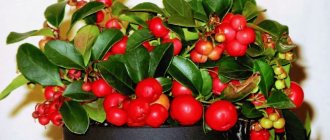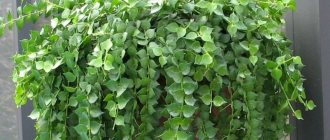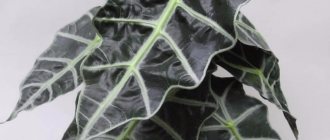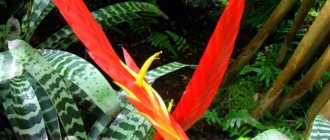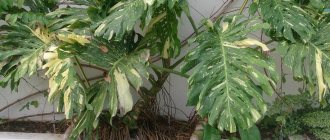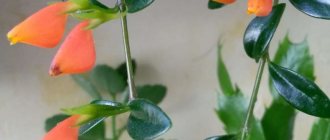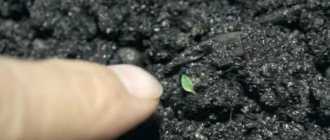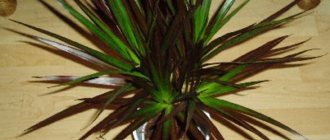Wintergreen (Gaultheria), also known as snowberry or mountain berry, is a low, evergreen shrub belonging to the Ericaceae family. In nature, the plant can be found on the mountain slopes of North America, Argentina, Chile, Australia and Asia.
The name of the culture comes from Jean-François Gautier, an eighteenth-century Canadian botanist and physician. The height of representatives of the genus is from 10 to 70 cm, depending on the species. Low-growing shrubs are more common.
Description
The plant blooms in mid-summer. The flowers are small, bell-shaped, fragrant, white or pink, and their appearance is very similar to Erica or lily of the valley flowers. In October, shiny spherical fruits ripen, which represent the main decorative value of the crop.
Bright berries abundantly decorate the bush until spring next year. The fruits are edible, but their taste is low. The leaves of the plant are small, shiny, dark green. In autumn they turn red, purple and crimson.
All parts of the plant contain essential oils that are saturated with methyl salicylate, a compound with strong analgesic, anti-inflammatory and disinfectant properties, similar to all known aspirin. Wintergreen oil with the camphor aroma is used in folk medicine, cosmetics and the food industry.
The North American Indians were well aware of the properties of the plant - they used the fruit for food, chewed the leaves and roots to strengthen the gums, and brewed medicinal and tonic tea.
Therefore, many gardeners grow wintergreen not only for its decorative appearance, but also as a powerful natural medicine with a wide range of uses.
Pernettia care at home. Pernettia Pernettya
Pernettia Pernettya
Pernetia is a beautiful shrub plant of the heath family. Homeland - South America, Tierra del Fuego island. The genus Pernettya includes about 20 species of evergreen shrub plants.
The most common in indoor culture is the pointed pernepia (Pernettya mucronata) with many straight thin stems and small dark green glossy oval-lanceolate pointed leaves. The flowers are small white, similar to Erica flowers, bloom in late May early June. The main value of this plant is its fruits, which appear in the fall and remain on the plant throughout the winter. The berries are very decorative - round in shape, when ripe they acquire a marbled color - from pink to purple. The berries are not poisonous, although they are not used as food due to the lack of any taste.
Pernetia is, in principle, an outdoor or greenhouse plant, but for the first 2-3 years this plant can be grown indoors.
Pernetia care:
Location: Since the more light, the more fruit the pernettia produces, the plant is usually placed in places with good lighting - on or near a windowsill. In the summer, it is better to expose the plant to the open air.
Temperature: The plant is not demanding on temperatures - it can withstand both high and low temperatures. However, in winter it is better to place the plant in a cool room with a temperature of 12°-15°C. If this is not possible, the plant should be placed closer to the glass and fenced off with film from the central heating radiators.
Watering: Water as needed, avoiding drying out the top layer of soil.
Humidity: when grown indoors, requires regular spraying.
Fertilizer: Feed the plants with complete mineral fertilizer (preferably acidic). You can use Kemira Universal.
Soil: any acidic soil is suitable, for example, soil for azaleas or a mixture of peat, leaf humus and fertile garden soil with the addition of complex fertilizer at the rate of 30 g per bucket of soil.
Transplantation: Transplanted once every 1-2 years. At the age of 4-5 years, it is recommended to plant the potted plant in open ground or use it as a large tub plant.
Reproduction: Since when sowing seeds, plants often do not retain the properties of the mother plant, pernettia is propagated by cuttings. Cuttings 5 cm long are taken in September-October and placed in a mixture consisting of sand and peat in a closed, unheated room. After the roots have formed, the seedlings are planted into pots one at a time. Young plants are planted in open ground when they are at least 1-2 years old.
Diseases and pests: Too high a pH value often leads to chlorosis, which is expressed as yellowing of the above-ground parts of plants. Use soil with a suitable pH; you can treat the plantings with appropriate preparations or ferrous sulfate. Root rot often occurs in waterlogged soil. In this case, temporarily stop watering.
Crown formation: In the spring, the pernetti bush is usually pruned to give it shape. In addition to shape, such pruning also stimulates the growth of new shoots. The cuttings remaining after pruning can be used for further propagation.
Types and varieties
The genus of culture has about 160 species, but only two of them are the most popular in garden design.
Wintergreen (Gaultheria procumbens) is native to the forests of North America. It is a rhizomatous, creeping shrub 10-15 cm high.
Shoots rise vertically from rhizomes. As it grows, one bush forms a dense soil cover up to half a meter in diameter, thanks to creeping and long rhizomes.
Young, shiny chocolate-red leaves eventually turn dark green. In autumn, the leaves turn all shades of purple and burgundy. Waxy, white flowers bloom in June-July. Fruits of a coral color with a characteristic tart taste.
The “Very Berry” variety is characterized by abundant fruiting.
Wintergreen pernettia (Gaultheria mucronata) is native to Argentina and Chile. The most decorative form of culture. Autumn sweet and juicy berries are larger in shades of blue, purple, pink or pure white.
The plant is dioecious, so to produce fruit it is necessary to grow male and female bushes. The height of the shoots is about 80 cm. The leaves are small, pointed, and turn red-bronze in autumn. Due to the shape of its leaves, this species is often called “potted myrtle.”
In garden culture you can find several spectacular varietal forms:
"Mulberry Wine" - purple-violet fruits;
"Crimsonia" is a cup-shaped shrub with large crimson fruits;
"Rosea" - pink berries and "Royal Red" - red;
"Pearl" is a dwarf shrub up to 15 cm in height with tiny dark green leaves and relatively large, white or pink berries;
"Snow White" - large white berries with a pink spot;
The Bell's Seedling variety is self-pollinating.
Wintergreen pernettia care at home. Wintergreen, or Pernettia acuminate
With its glossy green leaves and numerous small porcelain-beaded berries in pearly white, pink, burgundy or purple, wintergreen (Gaultheria mucronata) is the epitome of a miniature Tree of Paradise in flower shops from autumn to New Year's.
The Christmas holiday falls during the winter solstice, widely celebrated by pagans in ancient times. To distract early Christians from pagan traditions and instill Christian ones in them, scenes from the Bible about Adam and Eve were played on the streets of cities. The tree of paradise was decorated with artificial fruits, and in the northern countries coniferous trees were decorated. Instead of a bulky living Christmas tree, which is such a pity to throw away after the holidays, you can put in the room a pointed wintergreen, a recumbent wintergreen, and a crenate ardisia, which will symbolize the New Year and Christmas.
Wintergreen is marketed as Pernettia mucronata. Previously, species native to the Southern Hemisphere were classified in the genus Pernettya, and nurseries still retain the old name.
Wintergreen, or pointed pernettia (Gaultheria mucronata)
The plant is native to Southern Argentina and Chile, where it is found in moist and light forests or open areas. This is an evergreen shrub with tough, dense branches that forms dense thickets with the help of underground shoots. Under natural conditions, each individual plant can reach 1.5 m in height and about 1.2 m in diameter, but cultivated varieties are usually more compact. Leaves are 0.8-2 cm long and 0.3-0.6 cm wide, on short petioles, alternate, ovate, with a rounded base and pointed apex, finely serrate along the edges, dark green, leathery and glossy.
White bell-shaped flowers, typical of many members of the heather family, to which the genus Wintergreen belongs, completely cover the bush in the spring, and in the fall numerous pink or red berries about 1 cm in diameter appear. They remain on the plant until next spring, until new flowering. The plant is dioecious; male and female flowers bloom on different bushes.
When ripe, the fruits are sweet and juicy, but somewhat tasteless, with a texture reminiscent of polystyrene. The tribal peoples of Central and South America consumed them as a staple food, although the plant can often be found on lists of dangerous plants that cause hallucinations and paralysis.
Wintergreen, or pointed pernettia (Gaultheria mucronata)
In warm climates (USDA zone 7, down to -17.7°C), it is grown as an outdoor plant, used to create a low hedge, especially in a sunny location, where wintergreen forms dense stands.
Many varieties have been selected for gardening, differing in the size and color of the fruit, for example:
- Bell's Seedling - with dark red fruits about 1 cm in diameter.
- Crimsonia - with large raspberry fruits about 1.5 cm.
- Mulberry Wine - with purple-violet fruits.
- Sneeuwwitje - with large white fruits, often with a pink spot.
In the southern regions of our country, the plant can overwinter in open ground. Wintergreen prefers well-drained soils, sandy or loamy, always acidic and moist. Application of manure is prohibited. Grows well in full sun or light shade.
In more severe climates, wintergreen is grown indoors.
Growing wintergreen from seeds
Wintergreen can be propagated in two ways - vegetatively and by seed. Most often, vegetative propagation is used in cultural cultivation. This is due to the fact that seed propagation requires a special approach and conditions.
Sowing
Seed propagation is most often used when it is necessary to obtain a large number of wintergreen seedlings and sprouts. In addition, seed propagation guarantees the cultivation of healthy seedlings that are not susceptible to damage by pests.
Sowing of seeds is carried out after keeping the seedlings in the freezer or refrigerator for 3 winter months. For stratification, the seeds are mixed with moss or sphagnum and then tightly closed in a jar with a lid. The optimal temperature for stratification is about 5 degrees.
Sowing is carried out in early spring. To sow, you need to fill a container or container with a wide bottom with a peat-sand mixture. The soil is moistened before planting. The seeds are evenly distributed over the soil surface.
To create condensation, the surface of the container is covered with film or polyethylene. It is also appropriate to cover the container with glass. For optimal seed germination, place the pots on a window in a shady place. For ventilation, the film is removed daily. At room temperature, sprouts appear in 15-21 days.
After more shoots appear, the film is removed from the container. Plants should be provided with regular watering through a spray bottle. After three permanent leaves appear on the sprouts, young shoots are planted in separate pots or open ground (when constant warmth is achieved).
Planting in open ground
Planting in open ground is carried out after the bushes have grown to adults. Planting in open areas is carried out in pre-prepared soil with plenty of nutrients and drainage. The planting rules correspond to those that apply when planting adult individuals, described above.
